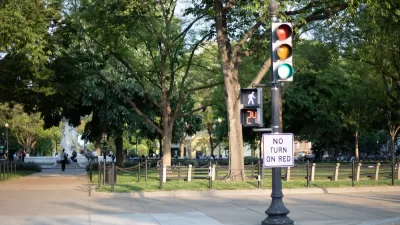A study examines whether and why bicyclists break traffic laws to shed light on how rational those laws really are.

In the Washington Post's "Tripping" blog, Fredrick Kunkle analyzes a study on the behavioral psychology of cycling. That is, the mental calculus cyclists perform to respond to variables like infrastructure, law enforcement, and other users of the road.
Perhaps unsurprisingly, Kunkle writes, "the upshot is that bicyclists are often trying to do the best they can when faced with moving dangers all around and a very small proportion of infrastructure restricted for their use."
The reason most bicyclists (71 percent) violate traffic rules is a bid for self-preservation. Other reasons include saving energy (56 percent) or saving time (50 percent) or attempting to increase one's visibility (47 percent). In other words, the study found that a large number of bicyclists tend to break the law because they think it will keep them safer.
If the way people ride bikes is a reflection of their needs on the road—along the lines of a desire path—then codifying the most common practices into law could better protect cyclists who find them necessary, the report suggests.
Kunkle's analysis comes ahead of the launch of dockless bikeshare in D.C., which is expected to expand ridership in underserved areas. Kunkle also examines other trends in the report, including how other road users navigate traffic laws and how cycling norms evolve in different places.

Maui's Vacation Rental Debate Turns Ugly
Verbal attacks, misinformation campaigns and fistfights plague a high-stakes debate to convert thousands of vacation rentals into long-term housing.

Planetizen Federal Action Tracker
A weekly monitor of how Trump’s orders and actions are impacting planners and planning in America.

In Urban Planning, AI Prompting Could be the New Design Thinking
Creativity has long been key to great urban design. What if we see AI as our new creative partner?

King County Supportive Housing Program Offers Hope for Unhoused Residents
The county is taking a ‘Housing First’ approach that prioritizes getting people into housing, then offering wraparound supportive services.

Researchers Use AI to Get Clearer Picture of US Housing
Analysts are using artificial intelligence to supercharge their research by allowing them to comb through data faster. Though these AI tools can be error prone, they save time and housing researchers are optimistic about the future.

Making Shared Micromobility More Inclusive
Cities and shared mobility system operators can do more to include people with disabilities in planning and operations, per a new report.
Urban Design for Planners 1: Software Tools
This six-course series explores essential urban design concepts using open source software and equips planners with the tools they need to participate fully in the urban design process.
Planning for Universal Design
Learn the tools for implementing Universal Design in planning regulations.
planning NEXT
Appalachian Highlands Housing Partners
Mpact (founded as Rail~Volution)
City of Camden Redevelopment Agency
City of Astoria
City of Portland
City of Laramie




























